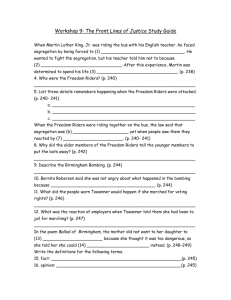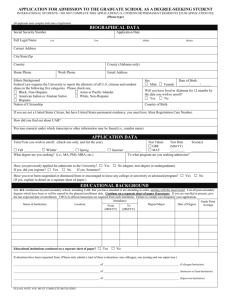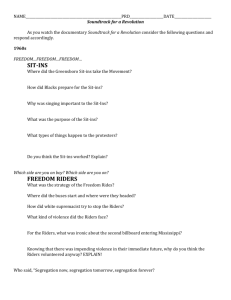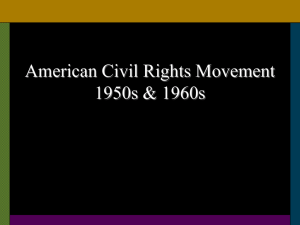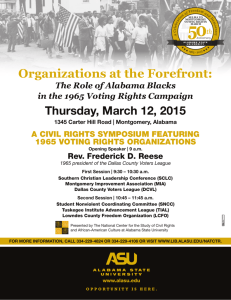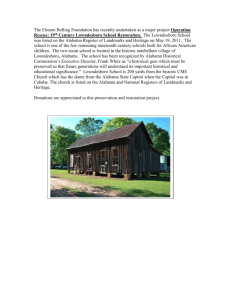*A Time For Justice* Outline
advertisement
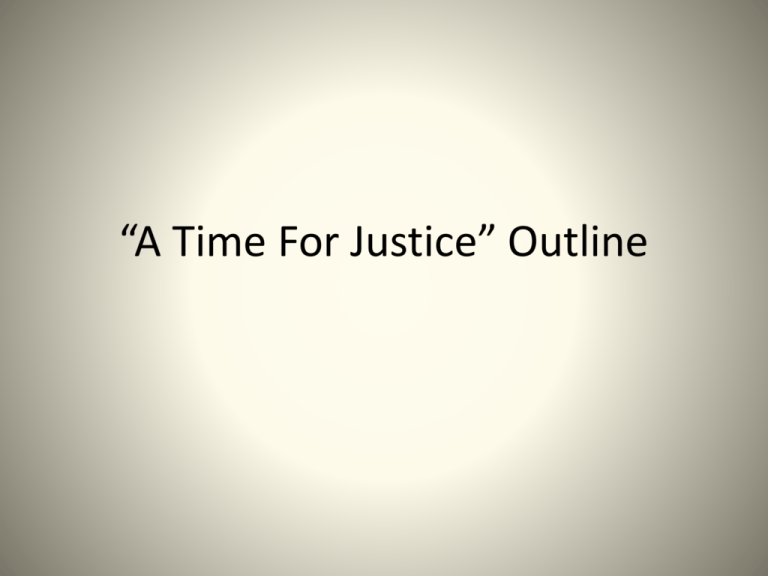
“A Time For Justice” Outline Murder of Emmett Till • Emmett Till a 14 year old African American boy from Chicago was visiting relatives in Mississippi in the summer of 1955 • Till made a comment to the local grocery store owners wife then whistled at her • Till was later kidnapped and murdered by the woman’s husband and his brother Murder of Emmett Till (Continued) • The two men were tried in front of an all white jury, and despite confessing to the beating were only charged with kidnapping and never with murder Murder of Emmett Till (Continued) What impact did this have on the Civil Rights Movement? • The trial drew national media and was broadcast into homes across the US • Till’s mother requested an open casket so that the entire country could see what was done to her son • Media involvement helped to spread word of the cause – Aimed at gaining the attention of those who didn’t care, or didn’t understand Montgomery Bus Boycott • Began in December on 1955 when Rosa Park refused to give up her seat to a white man on the bus and the bus driver had her arrested • As a form of protest the African Americans in Montgomery, Alabama banded together and refused to use public transportation until segregation of the busses ended Montgomery Bus Boycott (continued) • What impact did this have on the Civil Rights Movement? • Many African Americans used public transportation because cars were fairly pricey • When they stopped using public transportation the bus company lost a lot of money, and they had no choice but to integrate • It brought economic hardship to White Businesses in the South Montgomery Bus Boycott (continued) • Rosa Parks was a kind church going person and was a model citizen, so when she was jailed it attracted major media attention • As in the Till case it brought media attention to the cause! • First time Dr. Martin Luther King Jr. becomes involved on a major level in the Movement. The Integration of Little Rock Central High School, Little Rock, Arkansas • Little Rock Central High School was forced by federal law to integrate in September 1957 • 9 African American Students were to begin attending the high school that year, they are referred to in history as “The Little Rock 9” • The students were having a difficult time getting to school because of protests by white folks who did not want the school to integrate The Integration of Little Rock Central High School, Little Rock, Arkansas (Continued) • President Eisenhower called in federal troops to make sure the 9 students got to school safely - each student was assigned a soldier • Ernest Green the oldest of the 9 graduated in June 1958, first African American to graduate from the school The Integration of Little Rock Central High School, Little Rock, Arkansas (continued) What impact did this have on the Civil Rights movement? • When President Eisenhower called in federal troops the federal government was now becoming more involved in the integration movement • Heavily covered media event showed the strength of young people to the nation and inspired youth across the nation. Lunch Counter Sit-ins • February 1960 Greensboro, North Carolina • 4 black college students sat down at a Woolworth Department Store lunch counter that was “Whites Only” and refused to move until they were served. • They stayed there all day until the store closed, and then returned in the morning with more protestors • They continued this process for 3 days until the store was forced to close because of the angry mobs that were surrounding the protesters Lunch Counter Sit-ins (Continued) • People began to protest outside of Woolworth Department Stores in the north out of support for the students in the south. • By July 1960 the Woolworth lunch counter was forced to integrate by economic reasons Lunch Counter Sit-ins (Continued) What effect did this have on the Civil Rights Movement? • The Greensboro sit-in inspired sit-ins at lunch counters and other segregated buildings across the country • Media reported on the sit-ins and the violence surrounding them • The businesses that were targeted were hurt financially by the sit ins • Young people were at the heart of this particular protest and they were willing to take beatings and to go to prison for what they believed in because they had nothing to lose Freedom Riders • May 1961 • In protest of the continued segregation after the integration of interstate travel in 1946 of interstate bus travel CORE organized a group of mixed race protestors to ride buses from Washington DC to New Orleans • The group experienced some threats in Virginia and South Carolina but no physical violence Freedom Riders (Continued) • In Anniston, Alabama an angry mob attacked the bus and slashed the tires, then followed the bus until it had to stop for repairs then firebombed it • In Birmingham, Alabama the bus was attacked by the KKK and was given time by law enforcement to beat the Riders Freedom Riders (Continued) • In Montgomery, Alabama the Riders were again attacked, this is where they saw some of the most violent beatings –The mob was so bad that they took the cameras away from the news reporters and began beating the members of the media with their own equipment Freedom Riders (Continued) • After the beatings in Montgomery, Alabama the federal government ordered protection from the National Guard for the Freedom Riders • In Jackson, Mississippi the Riders were jailed for starting a riot Freedom Riders (Continued) What impact did this have on the Civil Rights Movement? • The federal government once again was forced to step in and help because it involved federal law • The media spread the news of the Freedom Riders across the nation, inspiring more Rides to begin that summer - they used their bodies as “living witnesses” Freedom Riders (Continued) • Other protests started through out the south they became more and more violent Birmingham, Alabama • 1963 • Protests in Alabama turn violent at the hands of Police - attack dogs, fire hoses, beatings were all used to break up Civil Rights Demonstrations • The children of Birmingham stage a march that draws national attention when they take impact of the police brutality Birmingham, Alabama (Continued) Impact on the Civil Rights Movement? • The movement becomes impossible to ignore!!! • The law enforcement in the south is exposed for their brutal tactics in the media. Birmingham, Alabama • Martin Luther King Jr. was arrested and thrown in jail Birmingham Jail -To gain attention for the movement he wrote a letter and released it to the media explaining why he took the actions he took even though it was a religious time of year Impact on the Civil Rights Movement? • A minister willing to go to jail on Good Friday, and the speech becomes one on the most famous of King’s speeches 16th Street Baptist Bombing • September 15,1963 • The KKK bombed the 16th Street Baptist Church in Birmingham, Alabama • 4 Young girls were killed in the explosion while getting ready for church service 16th Street Baptist Bombing (continued) • Man who placed the bomb originally was found not guilty of the murder, but in 1977 was found guilty of murder and was sent to prison where he died • The other men who helped to plan the bombing were arrested in 2002 and were sentenced to life in prison 16th Street Baptist Bombing (continued) Effect on the Civil Rights Movement: • Declared a national tragedy • Soon followed by the assassination of President Kennedy, the nation began to look for a way to heal and make the situation better Sarah Collins Rudolph was with her sister Addie Mae Collins when a bomb exploded in the 16th Street Baptist Church in Birmingham, Ala. The 1963 bombing killed her sister and three other girls, and Collins Rudolph was seriously injured in the attack. Freedom Summer 1964 • Thousands of civil rights activists from the began a drive to get African Americans in the south to vote • Many of these activists were white college students from the north • Mississippi was a targeted state • This was important because in order to get Civil Rights Laws passed, the black vote needed to be heard Philadelphia, Mississippi • During the voter registration drive three Civil Rights Activists working on a voter registration drive were killed by KKK members after being arrested for a minor traffic offense Freedom Summer 1964 (Continued) • Civil Rights Act 1964 – ended all segregation in in the United States including in voter registration and employment • MAJOR VICTORY!!!!! Bloody Sunday • February 1965 • Civil Rights Activist Jimmy Lee Jackson was shot and killed by the Alabama State Police • Jackson was unarmed and left to die Bloody Sunday (Continued) • March 7, 1965 • A march to protest the brutality of the police was planned from Selma, Alabama to the capital in Montgomery • During this march the protestors were beaten by the state police Bloody Sunday (Continued) • The protestors never made it to the capital • All was caught on video and brought to the attention of President Johnson • The march was held again on March 21 under federal protection and they were successful this time Bloody Sunday (Continued) What effect did this have on Civil Rights? • It showed the federal government once and for all the brutality that was occurring at the state level In August 1965 the Federal Voting Rights Act of 1965 was passed and it allowed the Federal Government the right to oversee all ELECTIONS

